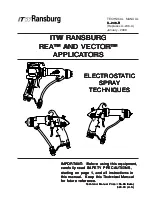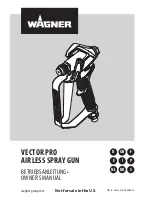
Intermediate Problem Solving
TYPE OF PROBLEM
WHAT TO CHECK
If check is OK, go to next check
WHAT TO DO
When check is not OK, refer to this column
Low output
(continued)
3. Release gun trigger. Observe resting position of
pump rod (107).
3. If pump consistently comes to rest with
rod (107) fully extended, the piston pack-
ings and/or piston valve may be worn.
Service the pump. See page 21.
4. Check electrical supply with volt meter. Meter
should read 105–125VAC.
4. Reset building circuit breaker; replace
building fuse. Repair electrical outlet or
try another outlet.
5. Check extension cord size and length; must be
at least 12 gauge wire and less than 150 ft
(45 m) long.
5. Replace with a correct, grounded exten-
sion cord.
6. Check motor brushes. See Electrical – What To
Check, item 4, on page 13.
6. See page 19.
7. Check motor start board (47) by substituting
with a good board.
CAUTION: Do not perform this check until mo-
tor armature is determined to be good. A bad
motor armature can burn out a good board.
7. Replace board. See page 26.
8. Check motor armature for shorts by using an
armature tester (growler) or perform motor test.
See page 17.
8. Replace motor. See page 25.
Drain valve leaks
1. Check drain valve for correct torque and/or
worn parts. Check for debris trapped on seat.
9. Tighten to 185 in–lb (21 N.m). Clean
valve and replace with new gasket (42a)
and sealant (42d). See page 32.
Transducer leaks
1. Slight leakage from transducer is normal.
1. Periodically remove residue from its cyl-
inder port. See page 30.
No output: motor runs and
pump strokes
1. Check paint supply.
1. Refill and reprime pump.
2. Check for clogged intake strainer.
2. Remove and clean, then reinstall.
3. Check for loose suction tube or fittings. See
page 31.
3. Tighten; use thread sealant on npt
threads of adapter (38).
4. Check to see if intake valve ball and piston ball
are seating properly. See page 21.
4. Remove intake valve and clean. Check
ball and seat for nicks; replace as need-
ed. See page 21. Strain paint before us-
ing to remove particles that could clog
pump.
5. Check for leaking around throat packing nut
which may indicate worn or damaged packings.
See page 21.
5. Replace packings. See page 21. Also
check piston valve seat for hardened
paint or nicks and replace if necessary.
Tighten packing nut/wet-cup.
6. Release gun trigger. Observe resting position of
pump rod (107).
6. If pump consistently comes to rest with
rod (107) fully extended, the piston pack-
ings and/or piston valve may be worn.
Service the pump. See page 21.
No output: motor runs but
pump does not stroke
1. Check displacement pump connecting rod pin
(17). See Fig. 17, page 21.
1. Replace pin if missing. Be sure retainer
spring (18) is fully in groove all around
connecting rod.
7. Check connecting rod assembly (15) for dam-
age. See page 27.
7. Replace connecting rod assembly. See
page 27.
8. Be sure crank in drive housing rotates; plug in
sprayer and turn on briefly to check. Turn off
and unplug sprayer. See page 27.
8. Check drive housing assembly for
damage and replace if necessary. See
page 27.
Summary of Contents for 820-169 Series B
Page 38: ...Notes...
Page 39: ...Notes...
















































